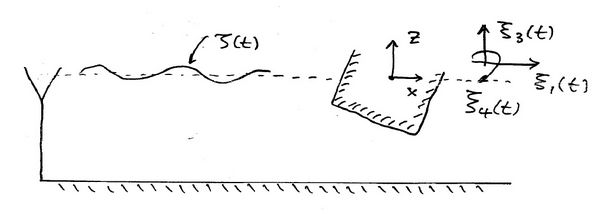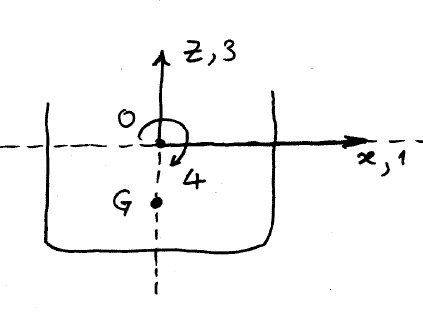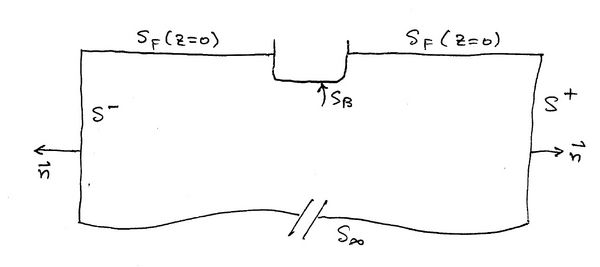Difference between revisions of "Linear Wave-Body Interaction"
m |
(→Heave) |
||
| Line 133: | Line 133: | ||
=== Heave === | === Heave === | ||
| − | <center><math> \sum_\mu \left[ -\omega^2 \left( M_{3\mu} + A_{3\mu} \right) | + | <center><math> \sum_\mu \left[ -\omega^2 \left( M_{3\mu} + A_{3\mu} \right) - |
\mathrm{i}\omega B_{3\mu} + C_{3\mu} \right] \zeta_\mu = f_3 (\omega), \quad \mu=1,3,5 </math></center> | \mathrm{i}\omega B_{3\mu} + C_{3\mu} \right] \zeta_\mu = f_3 (\omega), \quad \mu=1,3,5 </math></center> | ||
Revision as of 02:01, 12 February 2010
| Wave and Wave Body Interactions | |
|---|---|
| Current Chapter | Linear Wave-Body Interaction |
| Next Chapter | Long Wavelength Approximations |
| Previous Chapter | Ship Kelvin Wake |
We consider a Linear Plane Progressive Regular Wave interacting with a floating body in two dimensions (the main concepts survive almost with no change in the more practical three-dimensional problem).
Introduction
We derive here the equations of motion for a body in Linear Plane Progressive Regular Waves in the frequency domain in two dimensions. We begin with the equations for a fixed body and then consider the equations for a rigid body.
Frequency Domain Equations
We assume small amplitude so that we can linearise all the equations (see Linear and Second-Order Wave Theory). We also assume that Frequency Domain Problem with frequency [math]\displaystyle{ \omega }[/math] and we assume that all variables are proportional to [math]\displaystyle{ \exp(-\mathrm{i}\omega t)\, }[/math] The water motion is represented by a velocity potential which is denoted by [math]\displaystyle{ \phi\, }[/math] so that
[math]\displaystyle{ \Phi(\mathbf{x},t) = \mathrm{Re} \left\{\phi(\mathbf{x},\omega)e^{-\mathrm{i} \omega t}\right\}. }[/math]
The coordinate system is the standard Cartesian coordinate system with the [math]\displaystyle{ z- }[/math]axis pointing vertically up. The water surface is at [math]\displaystyle{ z=0 }[/math] and the region of interest is [math]\displaystyle{ -h\lt z\lt 0 }[/math]. There is a body which occupies the region [math]\displaystyle{ \Omega }[/math] and we denote the wetted surface of the body by [math]\displaystyle{ \partial\Omega }[/math] We denote [math]\displaystyle{ \mathbf{r}=(x,y) }[/math] as the horizontal coordinate in two or three dimensions respectively and the Cartesian system we denote by [math]\displaystyle{ \mathbf{x} }[/math]. We assume that the bottom surface is of constant depth at [math]\displaystyle{ z=-h }[/math]. Variable Bottom Topography can also easily be included.
The equations are the following
(note that the last expression can be obtained from combining the expressions:
where [math]\displaystyle{ \alpha = \omega^2/g \, }[/math])
where [math]\displaystyle{ \mathcal{L} }[/math] is a linear operator which relates the normal and potential on the body surface through the physics of the body.
The simplest case is for a fixed body where the operator is [math]\displaystyle{ L=0 }[/math] and we will consider this boundary condition first before moving on to floating bodies.
The equation is subject to some radiation conditions at infinity. We assume the following. [math]\displaystyle{ \phi^{\mathrm{I}}\, }[/math] is a plane wave travelling in the [math]\displaystyle{ x }[/math] direction,
where [math]\displaystyle{ A }[/math] is the wave amplitude (in potential) [math]\displaystyle{ \mathrm{i} k }[/math] is the positive imaginary solution of the Dispersion Relation for a Free Surface (note we are assuming that the time dependence is of the form [math]\displaystyle{ \exp(-\mathrm{i}\omega t) }[/math]) and
In two-dimensions the Sommerfeld Radiation Condition is
where [math]\displaystyle{ \phi^{\mathrm{{I}}} }[/math] is the incident potential.
Equations for a Fixed Body in Frequency Domain
The equations for a fixed body are
(note that the last expression can be obtained from combining the expressions:
where [math]\displaystyle{ \alpha = \omega^2/g \, }[/math]) The body boundary condition for a rigid body is just
plus the radiation conditions.
We decompose the potential as
[math]\displaystyle{ \phi = \phi^{\mathrm{I}} + \phi^{\mathrm{D}} }[/math]
where [math]\displaystyle{ \phi^{\mathrm{I}} }[/math] is the incident potential and [math]\displaystyle{ \phi^{\mathrm{D}} }[/math] is the diffracted potential. The boundary condition for the diffracted potential is
plus
Code to calculate the solution (using a slighly modified method) can be found Boundary Element Method for a Fixed Body in Finite Depth
Boundary Element Method for a Fixed Body in Finite Depth
Equations for a Floating Body in the Time Domain
The dynamic condition is the equation of motion for the structure in the frequency domain can be found from the time domain equations (Category:Time-Dependent Linear Water Waves) and are given by
The equations of motion for [math]\displaystyle{ \zeta_\nu\, }[/math] follow from Newton's law applied to each mode in two dimensions. The same principles apply with very minor changes in three dimensions. We use the standard numbering of the modes of motion.
Equations for the Radiation Potential in Frequency Domain
We decompose the body motion into the rigid body modes of motion. Associated with each of these modes is a potential which must be solved for. The equations for the radiation potential in the frequency domain are
(note that the last expression can be obtained from combining the expressions:
where [math]\displaystyle{ \alpha = \omega^2/g \, }[/math]) The body boundary condition for a radiation mode [math]\displaystyle{ m }[/math] is just
where [math]\displaystyle{ \mathbf{n}_{\nu} }[/math] is the normal derivative of the [math]\displaystyle{ \nu }[/math] mode on the body surface directed out of the fluid.
In two-dimensions the Sommerfeld Radiation Condition is
Code to calculate the radiation potential can be found in Boundary Element Method for the Radiation Potential in Finite Depth
We denote the solution for each of the radiation potentials by [math]\displaystyle{ \phi_\nu^{\mathrm{R}} }[/math] and the total potential is written as
Added Mass and Damping.
We substitute the expansion for the potential into the equations in the frequency domain and we obtain
We then define the matrices
which is called the added mass matrix and We then define the matrices
which is called the damping matrix and the forcing vector is
then the equations can be expressed as follows.
Surge
Heave
Pitch
The extension of these equations to six degrees of freedom is straightforward. However before discussing the general case we will study specific properties of the 2D Problem for the sake of clarity.
Symmetric body
Consider a body symmetric about the [math]\displaystyle{ X = 0\, }[/math] axis.
For a body symmetric port/starboard:
- Verify that Heave is decoupled from Surge and Roll. In other words the Surge and Roll motions do not influence Heave and vice versa:
- The only nonzero hydrostatic coefficients are [math]\displaystyle{ C_{33} \, }[/math] and [math]\displaystyle{ C_{44} \, }[/math]. Verify that this is the case even for non-symmetric sections.
- Surge and Roll are coupled for symmetric and non-symmetric bodies. The coupled equation of motion becomes:
Surge-Roll
- When Newton's law is expressed about the center of gravity:
where [math]\displaystyle{ I_G\, }[/math] is the body moment of inertia about the center of gravity. If the equations are to be expressed about the origin of the coordinate system, then the formulation must start with respect to [math]\displaystyle{ G\, }[/math] and expressions derived w.r.t. [math]\displaystyle{ O \, }[/math], via a coordinate transformation.
- The exciting forces [math]\displaystyle{ \mathbf{X}_1, \mathbf{X}_3 \, }[/math] are defined in an obvious manner along the X- and Z-axis. The Roll moment [math]\displaystyle{ \mathbf{X}_4 \, }[/math] is defined initially about [math]\displaystyle{ G\, }[/math].
Need to derive definitions for the coefficients that enter the Heave & Surge-Roll equations of motion:
Symmetry-reciprocity relations
It will be shown that
Along the same lines it will be shown that the exciting force [math]\displaystyle{ \mathbf{X}_j\, }[/math] can be expressed in terms of [math]\displaystyle{ \psi_j\, }[/math] circumventing the solution for the diffraction potential. The core result needed for the proof of the above properties is Green's second identity
where [math]\displaystyle{ \nabla^2 \psi_i=0 }[/math].
In the surface wave-body problem define the closed surfaces as shown in figure on the right. Let [math]\displaystyle{ \phi_j\, }[/math] be rediation or diffraction potentials. Over the boundaries [math]\displaystyle{ S^\pm\, }[/math] we have:
On [math]\displaystyle{ S_F: \qquad \frac{\partial\phi_j}{\partial z} = K\phi_j, \qquad \frac{\partial \Phi_j}{\partial n} = \frac{\partial \phi_j}{\partial z} }[/math]
On [math]\displaystyle{ S_\infty: \qquad \left| \phi_j \right|, \quad \left| \nabla \phi_j \right| \to 0 }[/math].
Applying Green's identity to any pair of the radiation potentials [math]\displaystyle{ \psi_i, \psi_j \, }[/math]:
It follows that:
or
Haskind relations of exciting forces
where the radiation velocity potential [math]\displaystyle{ \phi_i \, }[/math] is known to satisfy:
and
Both [math]\displaystyle{ \phi_i\, }[/math] and [math]\displaystyle{ \phi_7\, }[/math] satisfy the condition of outgoing waves at infinity. By virtue of Green's second identity
The Haskind expression for the exciting force follows:
The symmetry of the [math]\displaystyle{ A_ij(\omega), B_ij(\omega) \, }[/math] matrices applies in 2D and 3D. The application of Green's Theorem in 3D is very similar using the far-field representation for the potential [math]\displaystyle{ \phi_j\, }[/math]
where [math]\displaystyle{ R \, }[/math] is a radius from the body out to infinity and the [math]\displaystyle{ R^{-\frac{1}{2}} \, }[/math] decay arises from the energy conservation principle. Details of the 3D proof may be found in Mei 1983 and Wehausen and Laitone 1960
The use of the Haskind relations for the exciting forces does not require the solution of the diffraction problem. This is convenient and often more accurate.
The Haskind relations take other forms which will not be presented here but are detailed in Wehausen and Laitone 1960. The ones that are used in practice relate the exciting forces to the damping coefficients.
These take the form:
2D: [math]\displaystyle{ B_ii = \frac{\left| \mathbf{X}_i \right|^2}{2\rho g V_g}, \quad V_g = \frac{g}{2\omega}, }[/math] Deep water
3D: [math]\displaystyle{ B_33 = \frac{K}{4\rho g V_g} \left| \mathbf{X}_3 \right|^2 \, }[/math] --- Heave
(Axisymmetric bodies) [math]\displaystyle{ B_22 = \frac{K}{8\rho g V_g} \left| \mathbf{X}_2 \right|^2 \, }[/math] --- Sway
So knowledge of [math]\displaystyle{ \mathbf{X}_i(\omega)\, }[/math] allows the direct evaluation of the diagonal damping coefficients. These expressions are useful in deriving theoretical results in wave-body interactions to be discussed later.
The two-dimensional theory of wave-body interactions in the frequency domain extends to three dimencions very directly with little difficulty.
The statement of the 6 d.o.f. seakeeping problem is:
Where:
At zero speed the definitions of the added-mass, damping matrices and exciting forces are identical to those in two dimensions.
The boundary value problems satisfied by the radiation potentials [math]\displaystyle{ \phi_j, \ j=1,\cdots,6 \, }[/math] and the diffraction potential [math]\displaystyle{ \phi_7 \, }[/math] are as follows:
Free-surface condition:
Body-boundary conditions:
At large distances from the body the velocity potentials satisfy the radiation condition:
with
This radiation condition is essential for the formulation and solution of the boundary value problems for [math]\displaystyle{ \phi_j\, }[/math] using panel methods which are the standard solution technique at zero and forward speed.
Qualitative behaviour of the forces, coefficients and motions of floating bodies
The 2D Heave added mass is singular at low frequencies. It is finite in 3D
The 2D Heave damping coefficient is decaying to zero linearly in 2D and superlinearly in 3D. A two-dimensional section is a better wavemaker than a three-dimensional one
A 2D section oscillating in Sway is less effective a wavemaker at low frequencies than the same section oscillating in Heave
The zero-frequency limit of the Sway added mass is finite and similar to the infinite frequency limit of the Heave added mass.
In long waves the Heave exciting force tends to the Heave restoring coefficient times the ambient wave amplitude the free surface behaves like a flat surface moving up and down.
In long waves the Sway exciting force tends to zero. Proof will follow
In short waves all forces tend to zero.
Pitch exciting moment (same applies to Roll) tends to zero. Long waves have a small slope which is proportional to [math]\displaystyle{ KA }[/math], where [math]\displaystyle{ K\, }[/math] is the wave number and [math]\displaystyle{ A\, }[/math] is the wave amplitude.
Prove that to leading order for [math]\displaystyle{ KA\to 0 \, }[/math]:
where [math]\displaystyle{ C_{55}\, }[/math] is the Pitch ([math]\displaystyle{ C_{44} \, }[/math] for Roll) hydrostatic restoring coefficient. [NB: very long waves look like a flat surface inclined at [math]\displaystyle{ KA\, }[/math] ].
Body motions in regular waves
Heave:
Resonance:
In principle the above equation is nonlinear for [math]\displaystyle{ \omega\, }[/math]. Will be approximated below
At resonance:
Invoking the relation between the damping coefficient and the exicting force in 3D:
This counter-intuitive result shows that for a body undergoing a pure Heave oscillation, the modulus of the Heave response at resonance is inversely proportional to the modulus of the Heave exciting force.
Viscous effects not discussed here may affect Heave response at resonance
The behavior of the Sway response can be found in an analagous manner,
Estimating the Heave and Pitch resonant frequencies
Often it is useful to estimate the Heave and Pitch resonant frequencies in terms of the principal dimensions of a body.
Two dimensions
The Heave added mass [math]\displaystyle{ A_{33}, \, }[/math] is often not too far from its infinite frequency limit, or:
For a box-like section with beam [math]\displaystyle{ B\, }[/math] and draft [math]\displaystyle{ T\, }[/math]:
or:
We can derive corresponding result for Roll
Three dimensions
The extension to a 3D body of general shape is easy in principle
For a ship like body with length large relative to its beam, [math]\displaystyle{ B\, }[/math], we may approximate its shape as a barge with length [math]\displaystyle{ L\, }[/math], Beam [math]\displaystyle{ B\, }[/math] and draft [math]\displaystyle{ T\, }[/math]. In this case the 2D analysis is very accurate.
We can prove that the same resonant frequency [math]\displaystyle{ \omega^*\, }[/math] is applicable to the Pitch motion of the barge as well. So Heave & Pitch resonate at the same frequency. This result is very well verified by 3D computations.
Similar arguments apply to the Roll motion of a ship approximated as a box-like body. The resonant frequency from a 2D analysis is very close to the Roll resonant frequency for a slender ship.
This article is based on the MIT open course notes and the original articles can be found here and here


